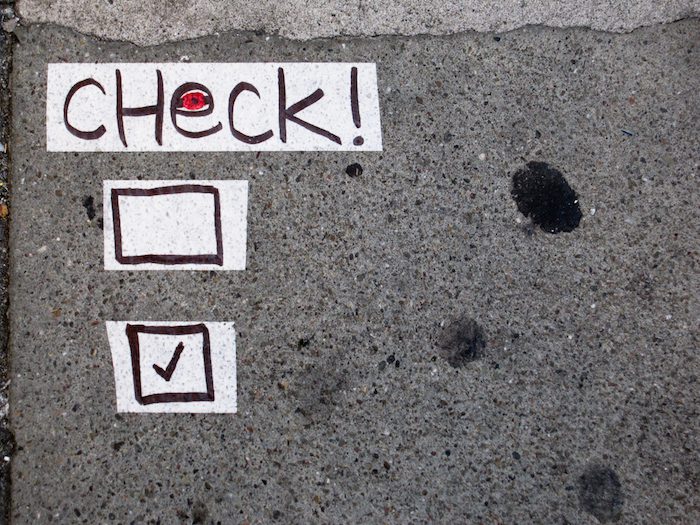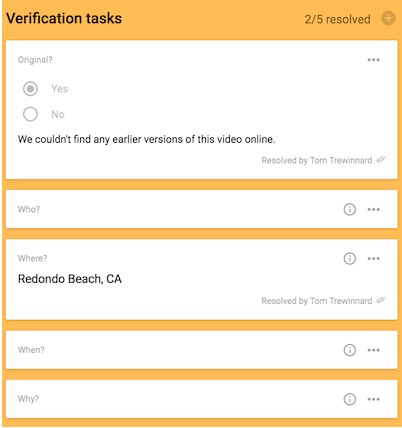
As part of its reporting processes, CrossCheck had to coordinate between newsrooms and keep track of multiple stories at once.
To manage the workflow, the team turned to Check, an open web–based verification tool developed by Meedan, a group working to build non-commercial tools for journalists and non-profit groups.
“If we had not had Check there as a tool, it would’ve been very difficult to manage that workflow,” said Sam Dubberley, CrossCheck’s managing editor. “It meant that people from different organizations could go in, see that the verification had been done, and then contribute or say, ‘I don’t agree with that,’ ‘I agree with that,’ or ‘I’ve seen something that might mean it’s true or not’ and so on and so forth. Having the collaborative aspect of Check as a platform was essential for CrossCheck.”
In addition to CrossCheck’s use of the tool in France, Check has been used in recent months by organizations across the globe covering elections in Hong Kong, the United Kingdom, and the United States. It’s also worked with groups such as ProPublica, which is using Check for Documenting Hate, its collaborative effort to track hate crimes in the United States. Amnesty International has also used the platform. Check (initially called Checkdesk) was totally redesigned last year. Its first major use was for Electionland, the 1,000-person collaborative reporting project led by ProPublica that tracked claims of voting issues on Election Day last fall.“We had already been on the path of switching from Checkdesk to Check with a new codebase — rails back-end and a react front-end — to really streamline the process,” Meedan product lead An Xiao Mina, a former Knight Visiting Nieman Fellow, said.
“We wanted to streamline the process, we wanted better performance, and we wanted it to be interoperable with an API that other people could adapt for their work,” she said. “Electionland helped accelerate that process.”
Users can upload social media posts, links, images, or other content to Check as part of their verification process.
Once an item is uploaded, it can be color-coded and tagged by subject matter. Users can regularly update the status of their reporting, add notes, and include other details that might be useful.


Everything is tracked in a log so users — whether they’re working alone or on a large team — can see how they or others have accessed and assessed the information being researched.

There’s also a Slackbot — called Checkbot — that newsrooms can activate to send alerts every time an item is updated to a dedicated Slack channel.
For now, Check is a tool for teams to use internally, but Mina said Meedan would ultimately like to build a public-facing version so outlets can show readers the steps they took to verify news.
“One of the ways…to build trust with audiences is showing the steps that you took, showing the process,” Mina said.
Meedan has worked with each of the outlets using Check to adapt the platform to its needs.
In Hong Kong, Anne Kruger, a professor at Hong Kong University, leads the Cyber News Verification Lab, which teaches students how to factcheck and debunk stories online.
The Lab, which covers stories from all over Asia, worked with Meedan to beta test an early version of the tool and add in new features that made it more useful for its coverage areas.
“When we first got that version, we could upload Facebook and Twitter,” Kruger said. “But Twitter actually isn’t that popular in Hong Kong. In Hong Kong, everyone wants to put up general links to blogs, yes, but we need Chinese characters up here. We need it to be able to read all links from everywhere, so if we’re uploading an online news article in Chinese, we want it to be able to be shown. We want them to be able to upload screenshots, we want them to be able to upload pictures.”
And because the Cyber Verification Lab is part of a class, Kruger is also able to use the iterative nature of the platform to track how students are going about their verifications — much the way math students have to show their work.
 For the CrossCheck effort in France, meanwhile, Meedan added new functionality to Check based on its experience with Electionland. It introduced task lists that were interactive and customizable to make sure reporters using the tool collected common data, and allowed teams to export the information in CSV format.
For the CrossCheck effort in France, meanwhile, Meedan added new functionality to Check based on its experience with Electionland. It introduced task lists that were interactive and customizable to make sure reporters using the tool collected common data, and allowed teams to export the information in CSV format.
“These task lists are customizable at the project level,” said Tom Trewinnard, Meedan’s director of business development. “You can have five projects looking at different themes or different types of media, and we can have different task lists for each of those projects, so as people are finding links and adding them to Check, they’re being prompted with relevant and appropriate tasks, not the same across the board.”
Meedan has also been able to streamline the verification processes. For instance, if something you upload includes an image, Check will prompt you to conduct a reverse Google image search.
“We’re trying to think through things that have to do with weather, location, or non-analytical and more functional stuff like archiving,” Trewinnard said. “How can we integrate those into Check?”
Last month Meedan also launched Keep, an archival tool for Check that saves videos uploaded to the platform in case the original uploads are deleted or removed.
For now, Check remains in open beta, but Meedan would ultimately like to make the service fully open source and also build up a developer community that can continue to build and adapt Check.
Meedan’s other main product is Bridge, a social media translation tool. One goal is to integrate Check and Bridge, though Trewinnard admitted that might still be a ways off.“That’s a longterm vision for Check,” Trewinnard said. “But I think we’ll manage that and translation will be one of the tasks that you see.”